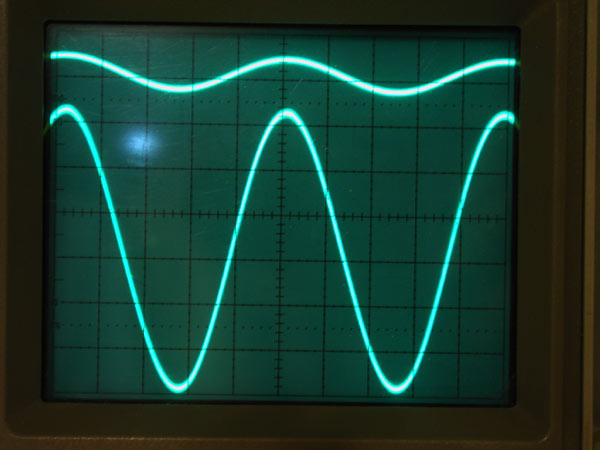My
DIY Pages Like it?Well, you should. Because that waveform shot is at the max gain before clipping which is already an impressive 30Vp-p !!!! And what's really impressive is it's doing this amplification to 30Vp-p of a 100Khz waveform AND the waveform still looks clean!!!! YES! 100 KILOHERTZ!!!! Yeay!
Here's the signal generator showing the 100 set on the dial, and the 1Khz multiplier.... as proof :) This is going to be good!!!!! It's getting late, so tomorrow, I'll connect the output of the pre to a potentiometer, then to the balanced driver stage. And No... I haven't heard the preamp yet. I'm just doing signal gen testing, looking at the waveforms and looking for signs of trouble like oscillation and things like that. But so far, so good. I'm liking what I'm seeing. To do: It's been a long wait, but I think it's going to be worth it. I am extremely pleased with the results I'm getting. And PCB rev3.00 will be even better. Update: Well, I spent some time working with the prototype. Noticed some slight oscillation at the 5th, 6th, and 7th gain settings of the selector switch. So finally fixed that with additional bypass capacitors on the supply rails. We're talking about less than 0.2Volts oscillation on top of a 30Vpp output. So it's insignificant. But still, it's gone now. :) As I said, this is Rev1.00 PCB I'm working on and it looks like on my Rev3.00 PCB, I've already incorporated those caps in the design. Then connected the mic pre circuit output to the balanced line driver. And what do you know... the less than 0.2Volt oscillation fixed itself. The addtl caps weren't needed. I can't wait any longer, and it's time to hear this with my own ears. So I connected my RP8 monitor to the preamp output jacks. And run the signal gen from 20Hz to 20Khz. (I didn't run it higher than that since I might burn out my tweeter!) The RP8 cannot reproduce 20Hz, and I only start to hear sound around 30+Hz... makes sense since the RP8 freq response is stated at 45Hz to 20Khz. It passes audio, sounds great! Gain selector switch working. Even at max setting of 66dB!!! Connected a dynamic mic. Very clean even at high gain settings. I sometimes thought the unit was off because I can't hear any residual noise when I have my ears near the RP8. Then I tap the mic and yup... it's on and working. Next, passed some music material. Very clean, no hum, no noise . Played "Misssing (Remix version)" by EBTG. Woohoo... the bass is so deep and clean and distinct. Not muddy. Played some synth heavy music. The highs and mids are very clear too. And quiet! No hum or noise. I think I'll probably build a 2nd prototype of the Rev1. PCB so I can listen to it on stereo! :) I still need to test this using a condenser mic. But from all signs, I think it will work just fine and just be as good. More update: Condenser Mic Testing/SM57 Mic Testing: Tried testing with some condenser mics today. Niiice! I just used +18V for the 48V phantom power since my bench psu doesn't have 48V. You don't necessarily need to have +48V for your condenser mics to work. The mics all worked just fine even at +18V, no problem! As for the sound... it really sounds very full and very nice. And I was blown away when I plugged in an SM57 dynamic. It *really* sounds great. Not boomy or thin, not harsh, but you can hear everything clearly. I don't have any high-end condenser mics, but I can tell you... even a cheap MXL 990 shines on this thing. Very clear. Lots of response. And yes, also tried a $20 Nady dynamic mic. It's not as great as the SM57, but it's still clean and quiet. A little lacking on the high end compared to the SM57.
Rev3.00 PCB Prototype So what's next?
I'm going to send PCB Rev3.00 (shown above) for a prototype run, build a couple of units using the Rev3.00 PCB, check the final parts list and bill of materials... and if those units work great (which I'm sure), I'm going to send the PCB out for mass manufacturing... mass as in maybe 100-250 PCB units. I'm just a small-time potato running this operation in the garage. What's new in Rev3.00? 1. Added J.W Miller inductors at the output for RFI protection Ordering Info I'm shooting for mid May to end of May when you can start ordering them. So start saving!!!! For sure, it will be less than $100 per channel (for the kit version, with all the PCB and parts included. Just supply your own soldering iron.) Discounts will be given for those purchasing 2 channels, or preamp and psu combo. Bigger discounts for those wanting to purchase 8 channels. The SC-1 preamp worked and it sounds great, very quiet, very clear, with a great freq response.
|





